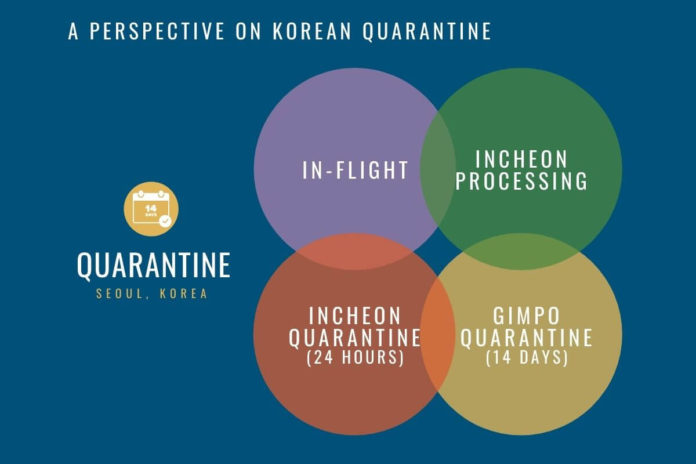Introduction
The following is a write-up based on my May 21 – June 5 experience in Korean quarantine. I’ve split my recollection into segments that are in a loose chronological order, partly because I don’t remember it in one fluid narrative and partly because it’s easier to skim this way.
DISCLAIMER. The Coronavirus situation in Korea is still very fluid. Korea’s policy could change at any moment depending on how infections progress or how public sentiment (towards incoming international travel) shifts. But even if the policy doesn’t change, your experience will likely differ from mine somehow. For one, you could be assigned to a different quarantine facility. If you happen to arrive at the same facility as me, you could have different staff. This might sound trivial but these are the people that manage your facility, and thus your day-to-day life. Even within the same facility, not all rooms are the same! Your AC unit could blow out moldy air like mine did or you could simply not have one. Your internet could be perfectly fine or it could struggle to load an Instagram video like my room’s internet did. So in the end, know that anything written below is not a promise of what will happen, but rather what happened to me and what could happen to you.
U.S. Airport (DTW)
PRE-FLIGHT HEALTH FORMS. The quarantine process technically starts at the gate of your departing flight. At least it did for my Delta flight. Before boarding, a pair of Delta employees set up a zone next to the gate where people were temperature scanned via IR gun before receiving health declaration forms to fill out. I don’t remember exactly how many there were or what was on them, but I’m willing to bet that I had to submit my name, nationality, passport number, flight number, countries visited on this trip, the purpose of visit, Korean address, and whether I had or was experiencing any symptoms of COVID-19. I had to submit this set of information on almost every form that I received.
I’m not sure if they asked for a Korean phone number here but know that you need one. This can be a friend or family member and they don’t have to speak Korean (though that definitely helps) but they do have to be able to contact you (e.g., via Kakao, WhatsApp, or otherwise). When I got tested for COVID-19, my test results went to the number that I provided them and I was presumably not allowed to leave or even go downstairs for discharge processing until I received those results. So be sure to ask around and find a willing someone with a Korean phone number to use.
KOREAN QUARATINE/REPORTING APPS. While you’re at it and have a functional SIM card, you might as well download the two Korean quarantine/reporting apps. You can input and verify your basic information from the States. You can also download them in Korea, but why wait and risk getting scolded for it?
In-Flight
CUSTOMS FORMS, AND OTHERS. If your flight was like mine, it will largely be the same as any other flight you’ve been on, except for that it’s almost empty and everyone is wearing masks. In addition to receiving the usual customs declaration and traveler information forms, you will also receive one or two more forms regarding COVID-19 (things like where you’ve been and how you’re feeling). Again, I don’t remember what was exactly on these forms, but name, nationality, passport number, flight number, countries visited on this trip, the purpose of visit, Korean address, and whether I had or was experiencing any symptoms of COVID-19 is a safe bet. Complete all of your forms before you land if you want a shot at securing a spot at the front of the quarantine processing line.
Also, you may become very hungry between the time you deplane and the time you receive your first meal. Consider squirreling away any airplane food you can to hold you over in case you get hungry between deplaning and your first meal, or between your first dinner and your first breakfast while you’re profoundly jetlagged.
Incheon Airport Processing
INITIAL SCREENING. Pull out your forms and your passport (I tucked my forms into the photo page of my passport) and bring them to the quarantine counter. Here, airport staff will view your temperature via infrared cameras and read your first set of forms as a sort of intake. Depending on what you’ve written and what you tell them, they will give you a lanyard or two, which presumably indicate what sub-process you belong in.
AT-RISK SCREENING. I reported that I had seasonal allergies and was consequently placed in an at-risk screening group. Around this part of processing, things start to move very fast, you’re given a lot of forms, you have to complete most of them, and not much is verbally explained to you. From deplaning to getting in the bus to go to my first quarantine facility, approximately two hours had passed and I only spent about 5 minutes idle.
After being directed from the first quarantine booth, I sat down with another worker and provided them the same information as I did to the previous worker. They gave me another set of forms and instructed me to move the next stage and that I could fill out the forms they just gave me while I waited. At this station, I showed them some forms and they gave me more forms before telling me to move on to the next station. At this next station, I received one more form to fill out and then took my spot in a bay of nooks. I sat for about 3 minutes before being told to follow the group and that I could leave my luggage in my nook until I came back. We walked across the airport to a different gate than we came into and waited while we went downstairs and outside in batches to get tested for COVID-19. When I got tested, I walked into a small converted shipping container and received my test while I was squatting forward, hands on knees, like one does for a photo. So don’t be surprised if there’s not a chair around if you get tested.
After getting tested, my processing group went back up to our nooks and stopped at one last checkpoint before proceeding with the normal customs and baggage claim process. At this final checkpoint, they called and confirmed that the Korean phone number that I provided them worked. I don’t think they would immediately deport you if your provided number doesn’t work, but it certainly won’t look good. After getting our bags, my group got on to a bus headed to our 24 hour quarantine facility.
Not that it matters much, but this is where the forms start to switch from “where have you been” and “how are you feeling” to “do you consent to these health checks” and “will you abide by our COVID-19 policy? If not, you must leave the country”. The rules are pretty simple and very clear. If you have a moment or are the concerned type, I would take a minute to read the forms you’re signing.
Incheon Quarantine (24 hours)
WAITING FOR TEST RESULTS. Because I reported that I was experiencing symptoms of COVID-19, I was immediately tested for COVID-19 and sent to a 24 hour quarantine facility until my test results came back. This facility, like most quarantine facilities, was simply a converted hotel across the street from Incheon’s Paradise City. We arrived around 7:30pm and received a mask, a small information packet, and a convenience store bibimbap for dinner. I think there was bottled water in the mini-fridge.
Here, I ate, slept (as jetlag allowed), and took my first post-flight shower before receiving a call around 6:00 am. The call was telling me that my test results were delivered to my provided phone number and that I needed to receive them and make it down to the lobby by 6:30 am to take the bus to my actual quarantine facility at 7:00 am.
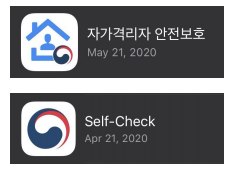
APP USAGES. At this facility, I used and was told to use the 자가격리 안전보호 app. I used it once, the night I arrived at the facility, and was told that I could delete it after I was discharged from this facility. I used the other app (“Self-Check”) from this point on.
Note: the morning that I left the Incheon quarantine facility, I went back to Incheon airport for an hour or so to wait for the bus to get ready. They let me stop by the airport convenience store for a moment to pick up snacks and drinks, but they may not let you do the same. But if they do, just know that this is your last chance to get anything that isn’t a convenience store meal for the next 14 days.
Gimpo Quarantine (14 days)
THE FACILITY. The facility itself was a converted marina hotel not too far outside of Gimpo Airport (link). It took about an hour to get there from Incheon Airport.
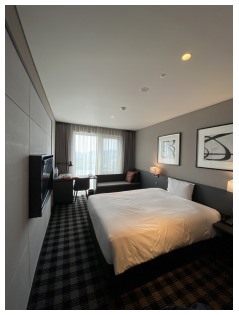
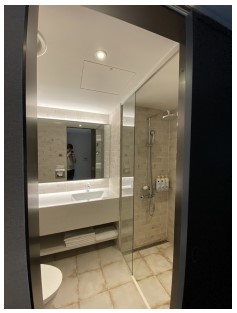
INTAKE. Here I received yet another form to fill out and spoke to a pair of health workers that took some standard health information but also explicitly asked me about any medications that I needed. If you take regular prescriptions or are carrying any with you, I would let them know.
After passing the health workers, I went up to a register and paid the 1,400,000 won for my quarantine. Before I got to Korea, someone had told me that you could only pay in cash. My quarantine facility also took credit cards, so you could earn points on your quarantine experience, if you’d like. I would still bring cash though.
“CARE PACKAGES”. If you’ve been waiting for photos of an extravagant “care package” from the Korean government, you’re about to be disappointed. There was a bag of basics in my room when I arrived, though the contents were more along the lines of bottled water and biohazard-marked garbage bags than ramen and other fun goodies.
The full contents of the bag in my room were two 2L bottles of water, 5 packs of green tea, 5 packs of instant coffee, two large stacks of small paper cups, a bag of orange biohazard-labeled garbage bags (more than 15), a tube of toothpaste, a toothbrush, a bar of laundry soap, a spray bottle of disinfectant (for your garbage), and a box containing a set of masks and a digital thermometer, and finally a set of informational flyers and packets.
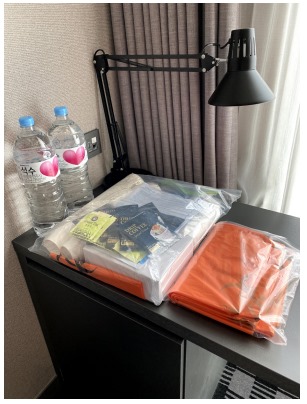
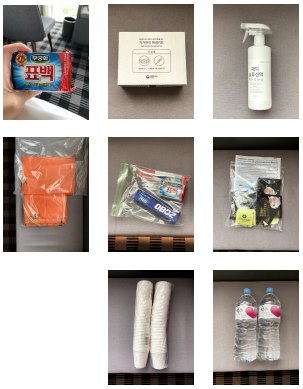
My mother (whose number I provided in my quarantine forms) told me that the Korean Public Health Office had called to confirm my quarantine location and address, presumably to send me one of the fabled care packages, but it never came. If a similar thing happens to you, I would ask your help desk (more below) about it.
ANNOUNCEMENTS AND THE HELP DESK. After every meal is delivered, at the start of every medical check period, and whenever someone has left their room or has smoked in their room, you will hear an announcement from the help desk staff. The help desk staff is kind of like the hotel manager of quarantine. They’re responsible for most of your day-to-day life and seem to coordinate things coming and going from the facility. They can be reached from your room phone. All of the help desk staff that I’ve spoken with have been able to speak English, but to different degrees. If you have a question, I would ask them. If the answer is important to you, I would press them on if they’re sure or not.
MEDICAL CHECKS. Once a day, sometime between 4pm and 5pm, a fully-suited medical worker will come by your door and take your temperature via an infrared thermometer. I believe this is the temperature that you are supposed to report in your quarantine/self-reporting app. I actually missed my first medical check because I was sleeping, but I also already submitted my temperature for the day before that. So if you miss one, you probably won’t be deported, but I wouldn’t make a habit of it.
MEALS. Meals came three times a day: 7:30am, 12:30pm, and 6:00pm. The meal announcement, which is the official signal for when you’re allowed to open your door to receive your meals, doesn’t come until much later, sometimes 30 minutes later.
First, I’ll say that the food wasn’t terrible. It certainly wasn’t great, but you can survive and not be miserable for eating quarantine food for 42 meals in a row. If you don’t believe me, make sure that you pack whatever it is you expect to crave in your checked baggage or be really quick at any potential convenience store stop in the airport. I’ve heard that people outside of quarantine can also mail you packages, but your mileage may vary, as this was explicitly discouraged at my facility.
Meals were always some form of convenience store lunch box. The formula was essentially a large box, a container of soup (lunch and dinner) or porridge (breakfast), a drink (usually a bottle of water), and a fruit cup or other snack. For breakfast, I would often receive a milk box and a small cup of cereal. Lunch and dinner came with a large box of cooked white rice. Everything always came lukewarm.
No lunch box was ever the same, but I saw a recurring cast of characters for sure. A lunch box would usually one or more of the following: fried pork cutlet, hot dogs, meat patties, and/or kimchi. I always found the size of the lunch boxes to be sufficient, but I also have no food allergies or dietary restrictions. If you have any food allergies or dietary restrictions, I would let the health staff know during your intake and also let your help desk know.
Finally, even though this only happened twice, and in the same day, I should let you know that I found moldy food in one of my breakfasts and a fully formed (but steamed to death) bug in my lunch rice once. I never found anything like that again but I would still advise checking your food. I’m really not sure, but my guess was that the meals wait at a staging area for some time post-heating but pre-transit (hence why they might be lukewarm) and that’s where mold might form? I don’t know. But since we’re going into the summer season, I would be on the lookout for mold and bugs in the food.
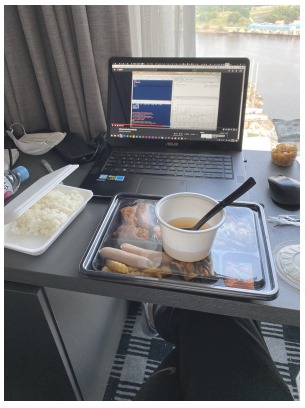

GARBAGE. Garbage was collected once a day, in front of my door, sometime around lunch time. I started off by putting my garbage bag out when I picked up my lunch, but I eventually realized that the staff were usually using the lunch delivery as the garbage collection time. After this realization, I started throwing my garbage out immediately after I finished my breakfast.
I rinsed all of my food containers after each meal and flushed any small and liquid food waste down the toilet before tying everything up in the bag that it came in. Even though I kept my garbage by my front door, a safe distance away from my bed, I really just didn’t want to smell anything from previous meals. You might have similar aversions.
INTERNET. As I talked with a quarantine neighbor on the bus out to the Express Bus Terminal Station, I heard that this lady’s internet was good enough to watch dramas throughout the day. My internet however was hardly strong enough to load an Instagram video. I would recommend bringing entertainment that doesn’t depend on the internet. Bring a few books, plan on learning to draw, do a lot of push-ups, something along those lines.
LAUNDRY. I did my laundry by hand every morning before breakfast. Doing laundry with the soap bar was simple enough. Wet the laundry, rub the laundry with the soap bar, lather the laundry with itself until suds form, rinse the laundry, and wait for the laundry to dry. The last step is actually why I did it in the morning. Because of how ventilation worked, or didn’t, in my room, hanging up my laundry in the morning was the only way to get a t-shirt, a pair of underwear, and one other non-thick article of clothing (pants, socks, etc.) dry by the end of the day. In addition to doing laundry every morning, I also stuck to two outfits for the 14 days. I figured if no one was going to see me, why should I bother unpacking and repacking my clothes and then planning an elaborate drying schedule? You might come to a similar conclusion.
OTHER AMENITIES. I did not have a microwave, but there was a water boiler. I had a large TV with Korean cable, but never turned it on. I had an AC unit but it blew out moldy air, so I stopped using it.
DISCHARGE. I’ve been told quarantine starts the day after you arrive in Korea. This sounds reasonable, but I had also been told by 3 different sources that my quarantine would last 17, 16, and 15 days. It ended up being 15 days total. Regardless, I would plan for up to 17 days, until told and confirmed otherwise.
I was first given a paper discharge form in a large plastic bag with a breakfast. The form asked for my preferred means of leaving the facility. It offered the options of being picked up by car (not taxi) at 12:00am-12:30am or 6:00-6:30am, or taking a bus to Seoul Station (7:30am) or Seoul Express Bus Terminal Station (7:00am). If you have someone willing to pick you up at midnight or 6 in the morning, power to you, but if not, Seoul Station isn’t a bad option. The buses are also free. You’ll notice that my form said that I was scheduled to leave on June 6, but I’ll let you know that I received a call the next day to “remind” me that I was leaving on June 5! Again, confirm important things.
The actual day of discharge went smoothly, aside from the elevator being broken and the room locking itself after I closed the door (PSA: your room key will likely no longer work once you leave the room). Just make sure that you make it to the bus on time. It took my bus about an hour to get to Seoul Express Bus Terminal Station. Once you arrive at your destination and get off the bus, Korean quarantine is officially behind you.












